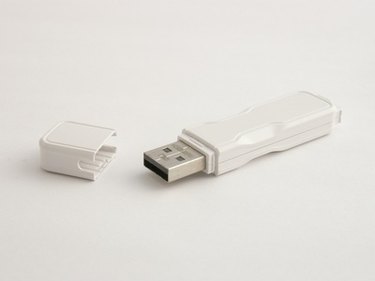
Using flash drives -- or "USB keys" since they are often on a key ring -- as part of a RAID array is possible in the same way that one might use standard hard drives in a RAID array. RAID stands for "redundant array of inexpensive disks." It is a method most commonly used to make automatic backup copies of files by making one disk make an exact copy of a second disk simultaneously. RAID can also be used to "span" disks, allowing two to operate like they were one larger disk. Both features are available in Windows 7.
Step 1
Attach your USB drives to your computer. Click "Take no action." Click the "Start" button and click "Computer." Note the drive letters for your two USB keys/drives.
Video of the Day
Step 2
Click the "Start" button, and then right-click "Computer." Select "Manage." Click "Storage" and then "Disk Management." A window appears listing all your available hard drives, including USB keys/drives.
Step 3
Right-click the first USB drive from which you would like to create a RAID partition. Select "Delete volume." This will create an "unallocated drive." Do the same for the second USB drive. Note the numbers of each drive -- they are labeled as "drive 1," "drive 2," and so on.
Step 4
Right-click the first USB drive again. Select "New Mirrored Drive." You will be asked which drives you would like to mirror. Note that this drive is already listed under "Selected." Click the second USB drive and click "Add."
Step 5
Click "Next." You will be asked if you are certain that you want to continue and you will be told that this process will create a single drive which is "mirrored," in essence allowing your two USB drives to copy each other exactly. Click "Yes." The new RAID drive is created.
Video of the Day